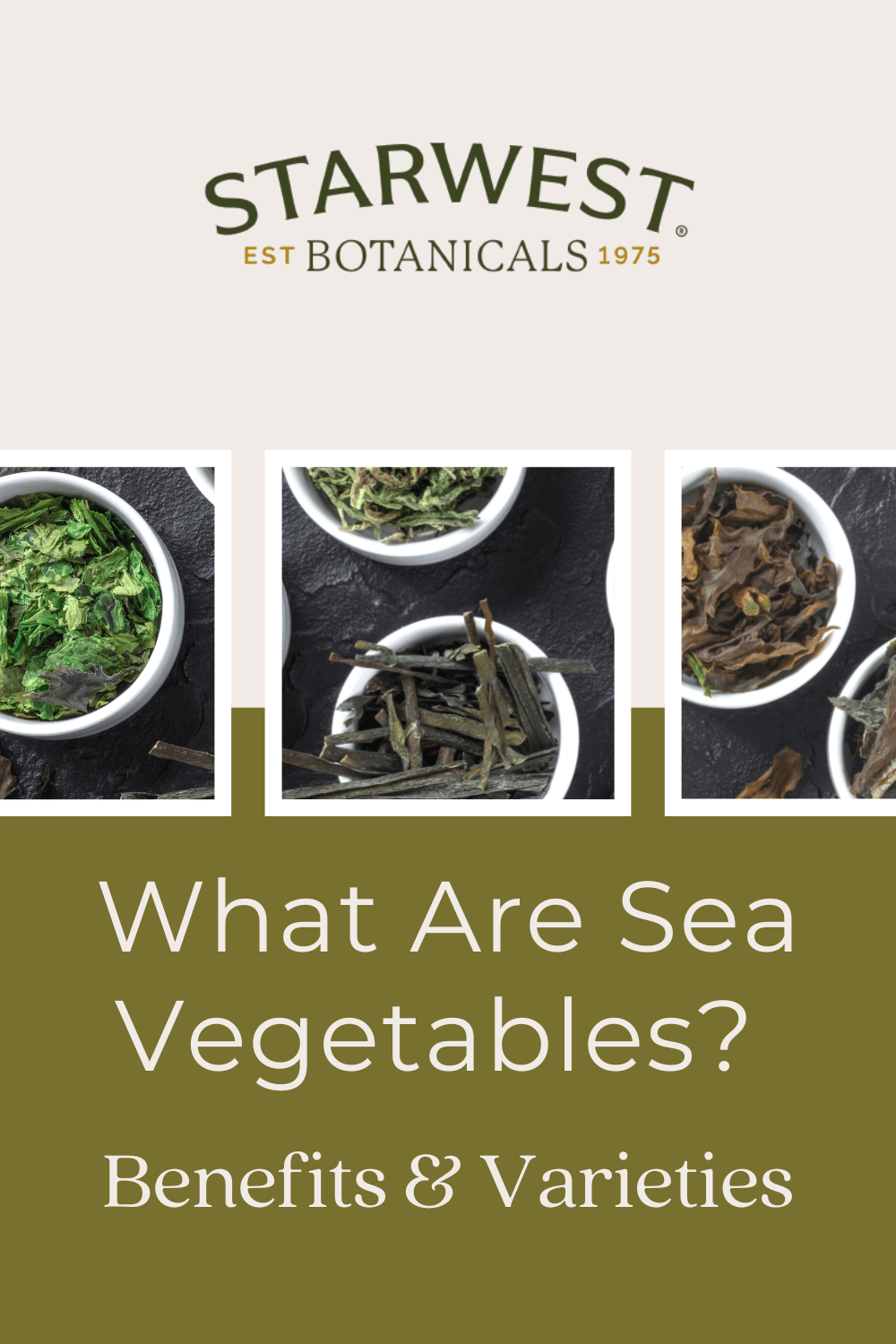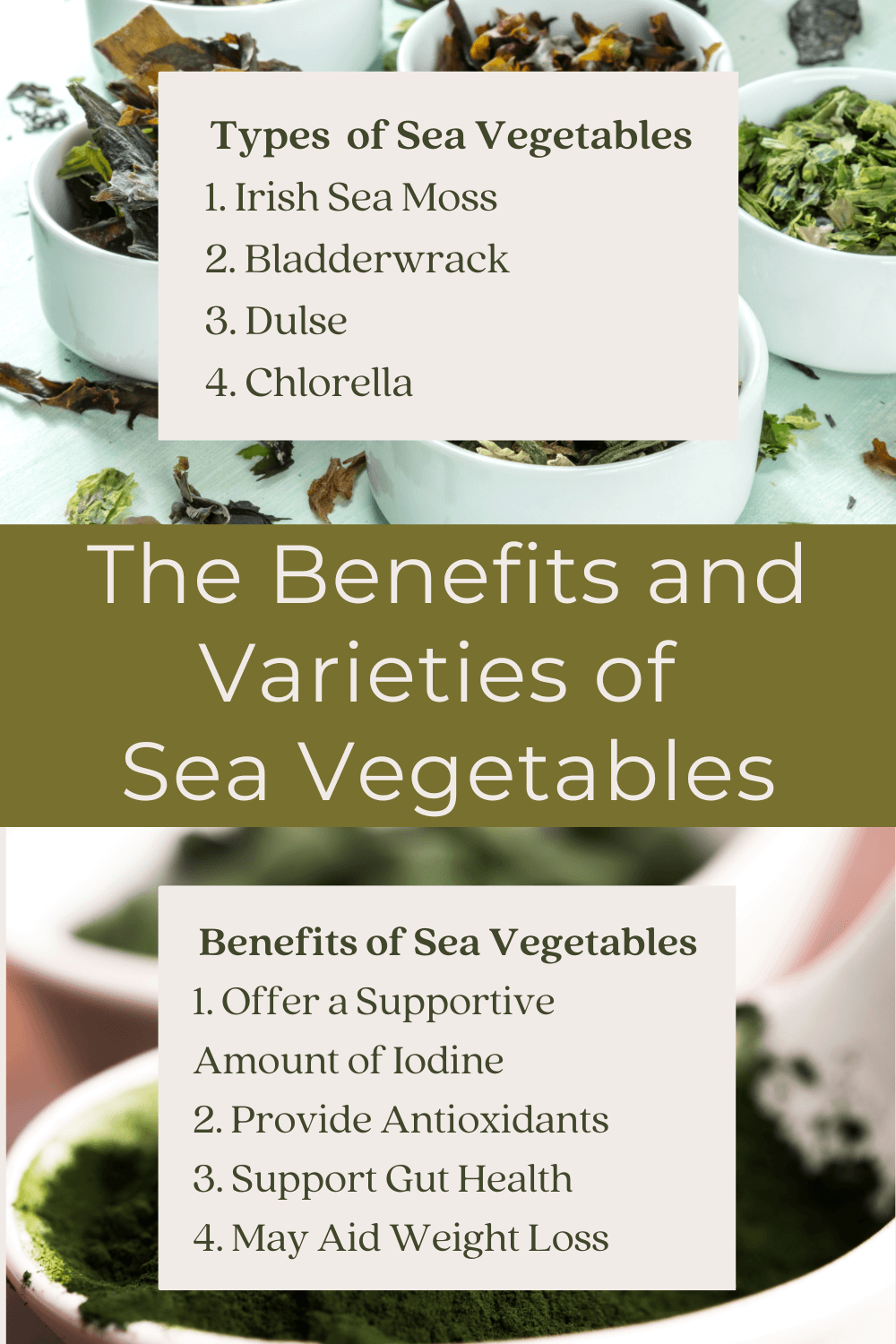What Are Sea Vegetables: Benefits & Varieties
Posted by Starwest Botanicals Content Team | Medically Reviewed by Daniel Powers, MS on 07-26-2022

From land vegetables like sweet potatoes and carrots to leafy greens like spinach and arugula, there are quite a few pickings of nutrient-dense produce you can add to your diet to meet your recommended four to five servings.
But there’s plenty of vegetables under the sea, too.
Sea vegetables like seaweed and chlorella are packed with antioxidants and have a wealth of potential health benefits. Plus, they bring a little variety to your daily veggie mix. Join us as we deep dive into all that sea veggies have to offer.
What Are Sea Vegetables, Exactly?
When you think of sea vegetables, the first thing that comes to mind might be the seaweed wrap (also known as nori) commonly used to make sushi rolls. If so, you’re on the right track.
While nori is probably the most well-known sea vegetable, edible seaweed only scratches the surface of the world’s many sea veggies.
Simply put, a sea veggie is any edible algae that grows in or near the ocean. Edible seaweed, or kelp, is classified as a sea vegetable, and it comes in a variety of colors, such as red, green, and brown. Its coloration can often be an indicator of whether it lives in shallow or deeper waters.
Other sea vegetables, such as the single-cell algae spirulina and chlorella, exist as well. Unlike kelp, which is a sea green, these single-cell algae live in freshwater environments.
While you might not find sea vegetables as readily available in the United States, many Eastern countries use them in their cuisine regularly, including:
- Japan
- South Korea
- China
From fresh to dried to powdered, these nutrient-rich vegetables are used as soup broths and toppings in a variety of international dishes. In Western cultures, they’re more often consumed as supplements, but their popularity in foods is quickly picking up steam.
Types of Sea 4 Vegetables (and How to Use Them)
There are countless sea vegetables under the sea. Below, we’ve compiled a popular list of sea vegetables you can add to your everyday life.
#1 Irish Moss
What is Irish sea moss? Despite its possibly misleading name, Irish Moss is not in fact a moss. This sea veggie is a red seaweed found on the coast of Ireland, Europe, and on the Atlantic Coast of the U.S. Its use dates back to the Irish Potato Famine when the Irish locals were known to harvest the edible algae and use it as a meal alternative. Many people also question if thereis a difference between Irish moss vs sea moss. While there are several varieties of sea moss, they both can be used interchangeably.
Since then, it’s gained popularity around the world as a natural thickening agent. That’s because it’s made of carrageenan, which has a jelly-like consistency. As such, people often use Irish Moss when making dishes like soups, puddings, or smoothies.
There are a few ways you can incorporate Irish Moss into your diet, including:
- Dietary Supplement – Supplements are used to provide you with extra nutrition to your daily regimen, such as vitamins, minerals, and antioxidants. Irish moss contains a high amount of omega-3 fatty acids and can be taken as a capsule or in powdered or dried form.
- Gel – When used as a gel, you can add it to a variety of foods or drinks to thicken the consistency. Simply put dehydrated Irish Moss in a container of water and let it rehydrate. Once rehydrated, combine them in a blender. The result is a gelatinous mixture that you can include in a variety of desserts, soups, or smoothies while adding little to no flavor.
#2 Bladderwrack
This aptly named brown seaweed derived its name from the air pockets in its leaves, which look like tiny bladders and help it stay afloat. Bladderwrack is harvested on both sides of the United States’ Northern coasts and on Europe’s Northern shores.
You can use this brown seaweed in a few different ways:
- Powder – Mixing the bladderwrack herb powder with water may aid your gastrointestinal health.
- Capsules – Bladderwrack also comes in capsule form, which may help support a healthy heart and thyroid function.
#3 Dulse
Dulse is a red seaweed found in chilly waters, namely the North Atlantic and North Pacific Oceans. From June to October, dulse harvesters carefully lay out fresh seaweed in the sun to dry so they can convert it to other forms before shipping it out for sale.
Rich in potassium, you can add dulse to your diet in its natural form or by combining it with other foods. Here are a few methods you can use to incorporate it into your meals and get one step closer to reaching all five servings of veggies:
- Fresh – If you enjoy the taste of nori, you might enjoy the taste of fresh dulse, which is slightly salty with just a hint of oceany-goodness.
- Flakes – For a boost of extra flavor, pour a sprinkle of dulse flakes over your salad, your favorite savory snacks, or your morning eggs.
- Dehydrated – This type of dulse pairs well with soups and stews for a little added zing.
- Powdered – If you’d rather add it to liquids, like smoothies or juice, powdered dulse is a perfect alternative.
- Capsule – Consumers simply interested in its health benefits can opt for a capsule instead. It’s flavor-free but jam-packed with minerals like potassium and calcium.
#4 Chlorella
Chlorella is a freshwater seaweed full of protein, vitamin B and C, and iron. Some people take chlorella supplements to support their immune system’s overall function. It may also help with certain gastrointestinal issues.
Because of its bitter and somewhat intense seaweedy flavor, many people interested in chlorella usually take it as a capsule to reap its benefits. However, if you’re interested in eating it in powdered form, you can try mixing it in the following to help mellow out its flavor:
- Smoothies
- Salad dressing
- Juice
- Flavored yogurt

What Are Some Benefits of Sea Vegetables?
Adding sea vegetables is a creative way to introduce a new food to your palate and help you achieve your veggie goal for the day. And because of their high levels of antioxidants, they may help support full-body health.
#1 Iodine Content
Getting an adequate amount of iodine may support your thyroid gland. Fortunately, sea vegetables contain sufficient amounts of iodine and can help you get the recommended 150 mcg your body needs daily.
#2 Antioxidants
Many types of sea vegetables contain high amounts of antioxidants, like vitamins A, C, and E, which may help to support your overall health.
Free radicals (unstable substances in your body) are caused by external sources, like air pollution, chemicals, and cigarette smoke. Having an overabundance of free radicals in your body is thought to contribute to poor overall health and accelerated aging.
Antioxidants are thought to neutralize free radicals and support overall health.
#3 May Support Gut Health
Most types of seaweed are high in fiber—accounting for 75% of dry seaweed’s overall weight—which may support your gut health. More specifically, fiber helps move waste through your digestive tract and filter it through your intestines more efficiently.
It may also promote the growth of healthy bacteria within your gut.
You’ll know your gut is in good shape when you experience:
- Daily bowel movements
- No noticeable bloating or gas
A healthy gut is the foundation of vibrant health.
#4 May Help With Wight Management
Adding high-fiber sea vegetables like nori can make you feel fuller for longer since they take longer to digest. This can help to quell cravings that you may experience throughout the day.
Of course, if you still feel hungry before your next meal, you can opt for other fiber-rich foods with ample nutrition, such as:
- Avocados
- Bananas
- Strawberries
- Chickpeas
- Edamame
- Artichoke hearts
Enjoy the Perks of Sea Vegetables with Starwest Botanicals
Sea vegetables like Irish Moss, bladderwrack, dulse, and chlorella provide a sea of wellness benefits, whether you’re looking to lose weight or support your gastrointestinal health.
And you can add them to just about anything—blend them in a morning smoothie alongside other fiber-packed foods like banana and strawberries or opt for a teriyaki vegetable dish complete with a sprinkle of dulse.
If you’re lost within the waves of sea vegetable varieties, look to Starwest Botanicals to guide you toward high-quality wholesale picks. We offer powered and flaked Organic Irish Sea Moss, Bladderwrack, Dulse, and Chlorella in addition to Agar Agar, Kelp, and Spirulina.
With over 45 years in the business, we pride ourselves on delivering quality botanicals and herbs from experienced raw material suppliers and farmers. Each of our products undergoes in-house quality control before stocking our shelves, and we implement an allergen protection program to prevent cross-contamination within our batches.
Our facilities also operate with sustainable environmental practices like renewable energy and recycling to reduce our carbon emissions and protect our planet.
When you shop with Starwest Botanicals, you’re getting the best.
Sources:
Hye-Rim Chung. Iodine and Thyroid Function. https://www.ncbi.nlm.nih.gov/pmc/articles/PMC4049553/
Harvard Health Publishing. Understanding Antioxidants. https://www.health.harvard.edu/staying-healthy/understanding-antioxidants
Frontiers in Microbiology. The Gut Microbiome as a Major Regulator of the Gut-Skin Axis.https://www.ncbi.nlm.nih.gov/pmc/articles/PMC6048199/
Ocean. What Is a Sea Vegetable? https://ocean.si.edu/human-connections/seafood/what-sea-vegetable
National Institutes of Health. Iodine. https://ods.od.nih.gov/factsheets/Iodine-Consumer/
Harvard Health Publishing. Understanding Antioxidants. https://www.health.harvard.edu/staying-healthy/understanding-antioxidants
Frontiers in Microbiology. The Gut Microbiome as a Major Regulator of the Gut-Skin Axis.https://www.ncbi.nlm.nih.gov/pmc/articles/PMC6048199/


